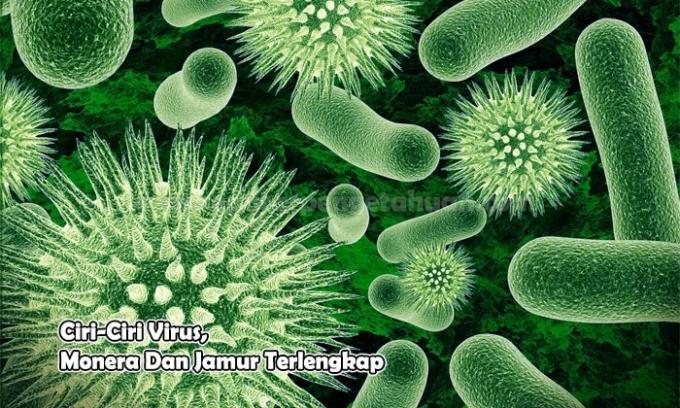Characteristics of Viruses, Monera and Fungi (Most Complete Discussion)
Characteristics of Viruses, Monera and Fungi (Most Complete Discussion) – In the discussion of this material, we will discuss about viruses, monera and fungi. First we must know the meaning of each of these living things.
- Virus is a microscopic parasite that infects cells of biological organisms and is an obligate parasite.
- Monera namely the non-organic group whose cell nucleus still does not have a nuclear membrane called prokaryotic organisms. Although it does not have a nuclear membrane, this type of monera still has a core material in the form of nucleic acids or DNA.
- Mold or fungi are included in the group of plants that do not have chlorophyll and are heterotrophs.
list of contents
-
Characteristics of Viruses, Monera and Fungi (Most Complete Discussion)
- Virus
- Monera
- Mold
- Share this:
- Related posts:
Characteristics of Viruses, Monera and Fungi (Most Complete Discussion)
The essential characteristics of the three groups of living things will be explained briefly and clearly below.
Virus
The virus was first discovered by Ivanovsky, namely TMV. The characteristics of the virus to remember are:
- They are millimicron in size and have a variety of shapes, some of which have a T-shaped, square, and round shape.
- Have only 1 kind of genetic material (RNA or DNA)
- Can form crystals or like inanimate objects (if the environment is not conducive)
- True obligate parasites (only live and reproduce in living things only)
Monera
Kingdom monera includes all prokaryotic microorganisms (does not have a nuclear membrane) consisting of:
Bacteria that have the following characteristics:
- Monocellular (solitary or colonies)
- Has a micron size, live aerobically and anaerobically
- Vibrio, bacillus, cocci and spiral shapes
- Autotrophs and heterotrophs
- Pathogenic and apatogenic
Cyanophyta (blue algae) which have the following characteristics:
- Monocellular and multicellular
- Reproduction by cell division and fragmentation
- Lives in fresh water, sea and in humid places
- Has color pigments (chlorophyll, phycocyanin)
- Autotrophic
- Can bind to hydrogen which can fertilize.
Also Read:4 Functions of the Human Skeletal Body and Their Explanation (Complete)
Example:
- One cell: Chroococcus, Gleocapsa
- Colono: Polycystis
- Like threads: Oscillatoria, Nostoc commune, Anabaena and Rivularia
In the latest classification, Cyanophyta are included in the group of bacteria and are named Cyanobacteria.
Mold
Fungi are a separate kingdom with the following characteristics: no chlorophyll, heterotrophs (parasites and saprophytes), eukaryotic, unicellular and multicellular.
- Multicellular fungal body shape like threads (hyphae), if woven called mycelium.
- Cell wall is composed of chitin
- Reproduction vegetatively (dividing themselves, spores and conidia); generatively ( conjugation: marriage of two compatible hyphae).
The main characteristics of the 4 groups of fungi are:
Zygomycota with characteristics:
- Saprophytic life in general
- Insulated hyphae
- Can form mycorrhizae
- Sexual reproduction by zygospores and asexually by sporangiospores.
Example: Rhizopus sp., Mucor mucedo
Ascomycota with characteristics:
- Insulated hyphae
- Form ascocarp (for multicellular)
- Spores are flagellated and immobile
- Asexual reproduction by conidia (multicellular) and budding (unicellular)
- Sexual reproduction by ascospores.
Example: Saccharomyces, Penicillium, Neurospora crassa, Fusarium.

Basidiomycota with characteristics:
- Body like an umbrella
- Saprophytic life
- Forms basidiocarp
- Generative and insulated hyphae
- Haploid monokaryon vegetative hyphae
- Asexual reproduction with conidia and sexual with basidospores.
Example: Auricularia polytricha (ear fungus), Volvariella volvaceae (edible mushroom), Puccinia graminis.
Deuteromycota with characteristics:
- Insulated hyphae
- Live as saprophytes and parasites
- No sexual reproduction, asexual with conidia
Examples: Aspergillus, Chladosporium, Curvularia.
Thus the discussion about Characteristics of Viruses, Monera and Fungi (Most Complete Discussion), hopefully it can increase knowledge and be useful for those who read.
